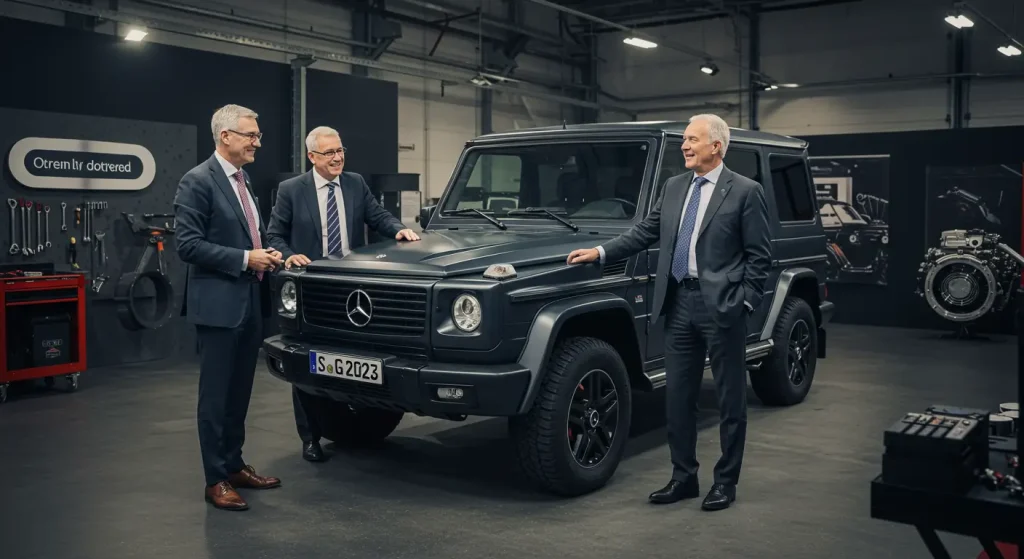When a vehicle consistently holds its value, evolves with time, and earns global admiration across generations, it becomes more than just a machine—it becomes a model for long-term success. The classic G Wagon by Mercedes-Benz is one such example.
Though born as a military utility vehicle, the G-Class has grown into a global icon of luxury and performance. And in doing so, it quietly offers some powerful lessons for executives and business leaders focused on resilience, brand identity, and adaptability.

1. Built to Last: Engineering for Longevity and Legacy
The G Wagon’s Military Roots: Designing for the Long Haul
Introduced in 1979, the G-Class—short for “Geländewagen”—was originally developed for military and rugged terrain use. Its ladder-frame chassis, solid axles, and naturally aspirated diesel engines were designed for endurance, not glamor.
Today, many early models are still on the road or being restored—a testament to its over-engineered durability.
Durability as a Competitive Advantage
For businesses, the takeaway is simple: longevity doesn’t happen by accident. Just like the G Wagon, companies built on strong fundamentals—clear values, solid products, and smart systems—stand the test of time. Quality is not a cost; it’s a long-term investment in brand equity.
2. Consistency with Evolution: Adapting Without Losing Identity
The G-Class Design Language—Unmistakable for Decades
One of the G Wagon’s most notable traits is its design consistency. Even the newest G-Class models retain the same boxy silhouette, vertical windshield, and visible door hinges of the originals. This design continuity reinforces recognition and loyalty.
Modern Upgrades, Same DNA
Despite the familiar exterior, Mercedes continually refines the internals—adding turbocharged engines, luxury interiors, and advanced technology. The brand’s ability to evolve without losing identity is a model for businesses navigating digital transformation, market disruption, or generational change.
Companies that adapt without abandoning their core values build deeper trust and stronger market positions.
3. Scarcity and Prestige: Mastering Niche Market Economics
From Utility Vehicle to Status Symbol
The G Wagon’s transformation into a global luxury status symbol didn’t happen overnight. Mercedes strategically controlled supply, especially for limited models like the Cabriolet or military-spec 250GD. This scarcity created demand, and demand led to prestige.
Understanding the Value of Controlled Supply
Not every business needs to be mass-market. In fact, controlling availability and refining quality can lead to higher margins, brand desirability, and long-term stability. Think Rolex, Patagonia, or Ferrari—brands that, like Mercedes, have mastered niche dominance.
Much like a well-led company, the classic G Wagon stands as proof that carefully maintained identity, strategic upgrades, and a clear purpose can deliver value across generations.
4. The Resale Market as a Business Metric
The G-Class and the Economics of Retained Value
The resale value of a well-maintained or custom-restored G-Class remains remarkably high. Whether it’s a 1994 250GD or a fully customized Wolf build, buyers are willing to pay a premium for a vehicle that delivers performance and story.
In some cases, restored classics sell for more than new G-Wagens—proving that value isn’t tied to age, but to quality and demand.
Customer Trust Through Product Performance
In business, retained value equals customer trust. When a product holds value over time, it reflects well on the brand behind it. Executives should measure performance not just by initial sales but by long-term user satisfaction and secondary market interest.
5. Lessons in Patience and Positioning: Why Slow Growth Wins
The G-Class Was Never About Trends
Unlike many vehicles that fade with shifting consumer trends, the G Wagon remained steady. Mercedes didn’t push out new G-Class models annually or chase flash-in-the-pan design fads. They refined slowly, released thoughtfully, and focused on timeless appeal.
Intentional Growth Over Hyper-Expansion
Executives can learn from this pace. Companies that grow methodically, listen to their customer base, and avoid overextending often weather market shifts better than those that scale without purpose. Sustainable growth beats rapid expansion every time.
6. Final Thoughts: Driving Success the G Wagon Way
The Mercedes G-Class didn’t become iconic by accident. It earned its status through consistent engineering, deliberate evolution, controlled positioning, and an unwavering sense of purpose.
For business leaders, the parallels are clear:
- Build on quality.
- Adapt without compromising identity.
- Choose depth over breadth.
- Focus on long-term trust over short-term gains.
The classic G Wagon isn’t just a vehicle—it’s a masterclass in long-term brand performance. For executives aiming to build lasting success, few roadmaps are as reliable or inspiring.
Source: Pedro Vaz Paulo







